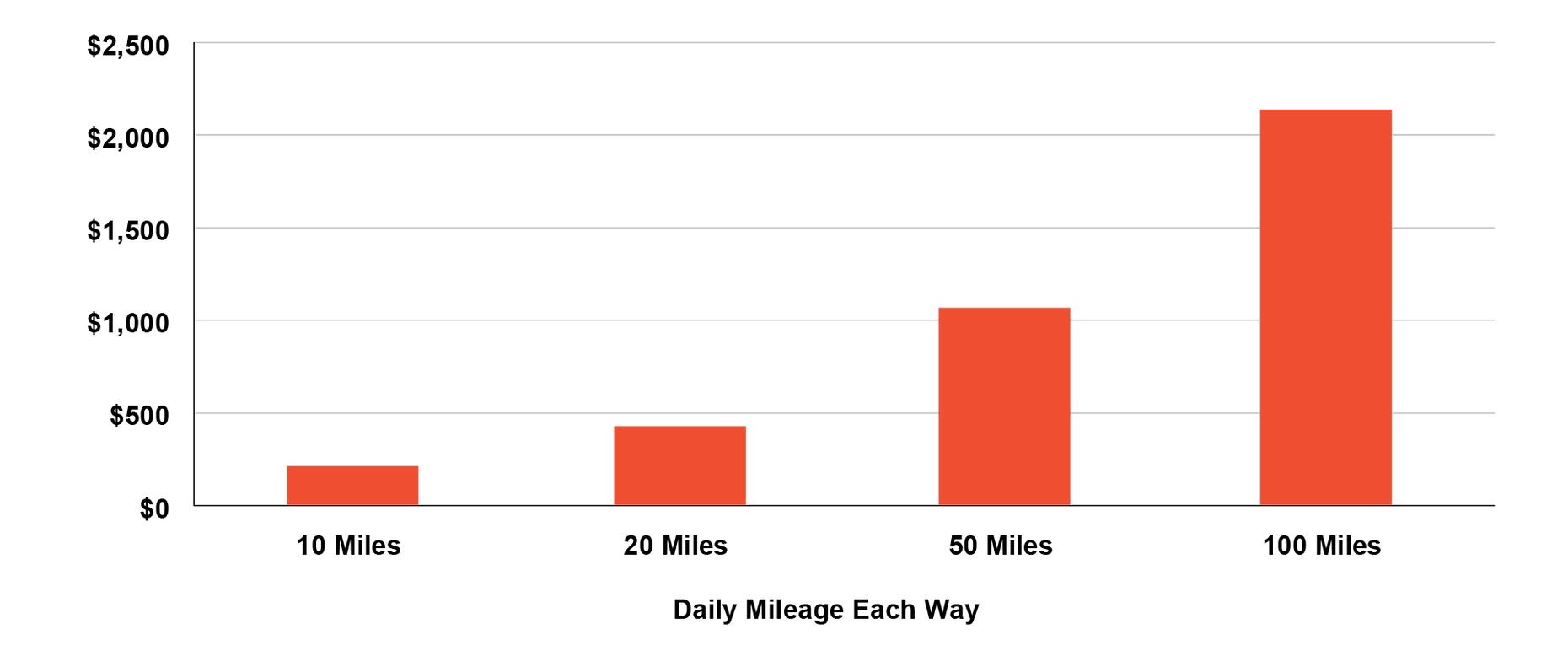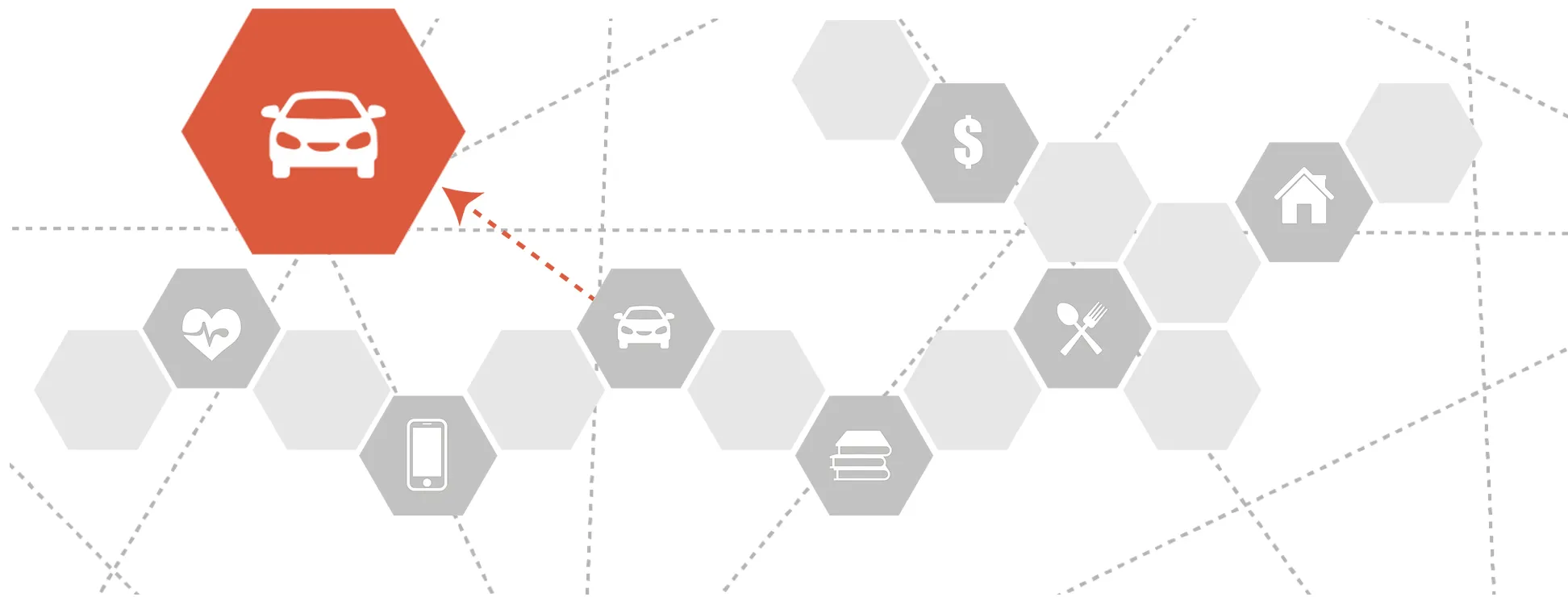
|
Housingclick to view |

|
Health Careclick to view |

|
Child Care and Educationclick to view |

|
Technologyclick to view |

|
Foodclick to view |

|
Taxesclick to view |

|
Transportationclick to view |
||
Future Trends: Transportation for ALICE
Commuting times will continue to increase: As workers seek ways to cut costs by finding less expensive housing further away from jobs or using slower but cheaper public transportation, commute times will increase. Long commute times increase tardiness and absenteeism rates and can have a negative impact on job retention, adding costs to businesses. Congestion from driving commuters also adds travel time and costs to the trucking industry, and those costs are then passed on to consumers.28 As shown in the figure below, a worker driving 10 miles each way to work every day spends, on average, $214 per month, using the Internal Revenue Service estimate of $0.535 per mile. A 20-mile commute each way doubles the cost; a 50-mile commute each way totals more than $1,000 per month.
Monthly Cost of Driving to Work by Mileage, 2017

Sources: Internal Revenue Service (2016, December 13). 2017 standard mileage rates for business, medical and moving announces
Urban sprawl will continue to grow: The appeal of lower-cost housing and reliance on driving continues to push workers to the suburbs and beyond. The development of new infrastructure, especially roads and public services (such as electricity, water, and waste management), costs the American economy more than an estimated $1 trillion annually. One study found that those living in the new communities directly bear $625 billion in extra tax burden, and all residents and businesses in the state, regardless of where they are located, bear an extra $400 billion in costs. Looking at transportation costs alone, development on the fringes of cities over a 15-year period costs nearly twice as much as redevelopment of inner-city transportation.29
Ride-hailing companies will continue to change the transportation options for ALICE families in two ways. First, the proliferation of ride-hailing companies like Uber and Lyft offers ALICE workers a source of additional income and a way to afford a vehicle. Yet these services also impinge on the traditional taxi and livery industries, where many drivers are also ALICE workers.30
Second, for ALICE families, using ride-hailing services for transportation can be more affordable than owning and maintaining a car, and more convenient because rides are available on demand. Rural areas, however, have benefitted less from these services, and pricing in some areas makes ride-hailing less accessible for ALICE (especially “surge pricing,” where prices increase during busy times).31
Self-driving vehicles are poised to transform the transportation landscape. In the future, fleets of publicly owned self-driving vehicles could provide transportation to doctors’ offices at a fraction of the cost of building a more accessible public transportation system. And if self-driving vehicles can offer lower-cost transportation and more productive commuting time, the proximity of housing to work and amenities might become less important, thereby increasing the range of locations for affordable housing. In addition, a reduced need for car ownership will change the demand for houses with garages, and for on-street parking.32
Sources
28
Remer, W. (2016, December 15). 2017 infrastructure report card: A big WIIN for water resources. American Society of Civil Engineers (ASCE). Retrieved from http://www.infrastructurereportcard.org/a/#p/home
National Economic Council and the President’s Council of Economic Advisers. (2014, July). An economic analysis of transportation infrastructure investment. The White House. Retrieved from https://obamawhitehouse.archives.gov/sites/default/files/docs/economic_analysis_of_transportation_investments.pdf
29
Litman, T. (2015). Analysis of public policies that unintentionally encourage and subsidize urban sprawl. The Global Commission on the Economy and Climate, The New Climate Economy. Retrieved from https://newclimateeconomy.report/wp-content/uploads/sites/5/2015/03/public-policies-encourage-sprawl-nce-report.pdf
Trubka, R., Newman, P., & Bilsborough, D. (2010). The costs of urban sprawl — Infrastructure and transportation. Environment Design Guide. Retrieved from https://www.crcsi.com.au/assets/Resources/b6e1625f-d90b-433d-945a-6afeff2e42f6.pdf
Coyne, W. (2003). The fiscal cost of sprawl: How sprawl contributes to local governments’ budget oes. Environment Colorado Research and Policy Center. Retrieved from http://www.impactfees.com/publications%20pdf/fiscalcostofsprawl12_03.pdf
30
Buchwald, E. (2018, September 25). Drivers for Uber, Lyft are earning less than half of what they did four years ago, study finds. Market Watch. Retrieved from https://www.marketwatch.com/story/drivers-for-uber-lyft-are-earning-less-than-half-of-what-they-did-four-years-ago-study-finds-2018-09-24
31
Wallsten, S. (2015, June). The competitive effects of the sharing economy: How Uber is changing taxis. Technology Policy Institute. Retrieved from https://techpolicyinstitute.org/wp-content/uploads/2015/06/the-competitive-effects-of-the-2007713.pdf
Stiglic, M., Agatz, N., Savelsbergh, M., & Gradisar, M. (2018). Enhancing urban mobility: Integrating ride-sharing and public transit. Computers and Operations Research, 90, 12–21. Retrieved from https://dl.acm.org/citation.cfm?id=3165324.3165603
32
Arcadis, HR&A Advisors, and Sam Schwartz. (2017). Driverless future: A policy roadmap for city leaders. Retrieved from http://driverlessfuture.webflow.io/
Jiao, J., Miró, J., & McGrath, N. (2017, November 3). Why the "Uberization" of public transit is good for cities. Houston Chronicle. Retrieved from http://www.houstonchronicle.com/local/gray-matters/article/Why-the-Uberization-of-public-transit-is-good-12329605.php
Zimmer, J. (2016). The third transportation revolution: Lyft’s vision for the next ten years and beyond. Retrieved from https://medium.com/johnzimmer/the-third-transportation-revolution-27860f05fa91

